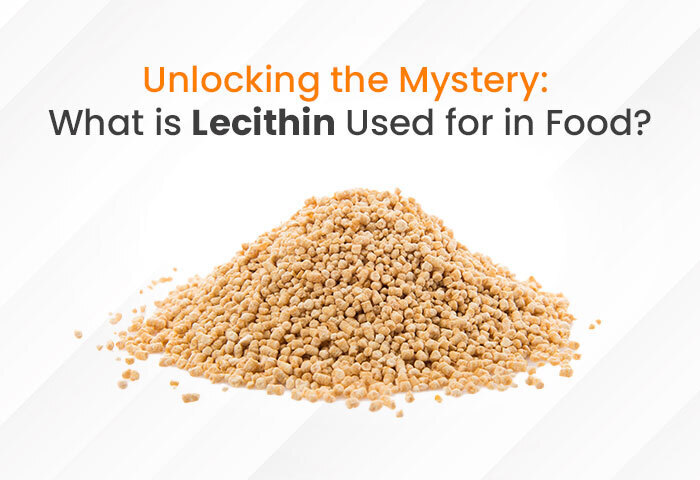Introduction
What is lecithin used for in food? If this question also bangs in your mind then this blog is for you. This question might lead you to a world of culinary secrets that could transform your cooking. Lecithin, often an unsung hero in the kitchen, works its magic behind the scenes to enhance textures, stabilise mixtures, and elevate flavours. Whether you’re whipping up creamy sauces, smooth chocolates, or perfectly emulsified dressings, lecithin plays a pivotal role. In this blog, we’ll delve into the fascinating uses of lecithin in food and show you how this versatile ingredient can take your culinary creations to the next level. Get ready to unlock the potential of lecithin and discover how it can become an indispensable part of your kitchen!
Why is lecithin added to foods?
Because it acts as an emulsifier in food. Yes, you read it right. Most people don’t know about this but Lecithin works as an emulsifier in so many ways. If you are confused about what an emulsifier is then it is a substance that helps mix two immiscible liquids, such as oil and water. Some examples of Lecithin as an emulsifier are mayonnaise, dressings, sauces, etc.
Lecithin is not an artificial emulsifier but a natural one. It is made up of phospholipids, which contain both water-attracting and water-repelling properties. As it has both properties this helps it to interact with both oil and water. This then helps to stabilise the emulsion and prevent separation. If we compare it with other emulsifiers, lecithin is very versatile and helps in a wide range of applications. These are the foods that contain lecithin as an emulsifier in their application.
- Baking
- Chocolate and Confectionary
- Dressing and Sauces
- Margarine and Spreads
- Dairy products and alternatives.
There are also many benefits of using lecithin as an emulsifier
- Natural origin – It is preferable as a clean-label product because of its natural form. It is naturally derived from soya beans, sunflowers, or even egg yolks.
- Versatility – From baked goods to dressings lecithin is suitable for a wide range of products.
- Health Benefits – The nutritional advantage of lecithin as an emulsifier is that it contains phospholipids which are beneficial for brain and liver function.
- Allergen-Friendly Option – Those who have soy allergy can try lecithin derived from sunflower seeds or other sources that provide a safe alternative.
What is lecithin used for in baking?
These are the purposes of Lecithin in food. Let’s take a look at them –
- Enhancing Dough Handling and Consistency – Its emulsifying properties help bind the dough together and make a smoother dough, making it easy to roll out and shape to make more uniform baked goods.
- Improving Volume and Texture – In baked products like bread, cakes, and pastries, lecithin contributes to a better crumb structure and improved volume. It spreads the fat evenly throughout the dough leading to a finer crumb texture and greater rise. This makes the dough lighter and fluffier.
- Moisture Retention and Freshness – It helps to increase the shelf life of the baked products by maintaining softness and preventing staleness. It prevents excessive moisture loss during baking, keeping the baked goods fresh longer.
- Enhancing Emulsification – The recipes that involve high-fat ingredients or require precise emulsification lecithin is really important. It ensures that fats and liquids blend seamlessly preventing separation and creating a uniform texture.
- Reducing Sticking and Crumbling – Lecithin can help reduce sticking and crumbling in baked goods. It enhances the overall quality and appearance of the finished product. It helps the dough by giving it the ability to leave the baked surface and reduces the tendency for items to fall apart.
Health Benefits of Lecithin
Now that we have gained almost all knowledge about lecithin, let’s get to know the benefits of it in food.
- Supports Digestive Health – Phospholipids present in lecithin aid digestion by emulsifying the fat in the digestive tract, which helps in improving nutrients absorption and prevents digestive issues.
- Heart Health – It is linked to improved cholesterol levels. It can help to increase good cholesterol and reduce bad cholesterol.
- Skin Health – Its moisturising properties help in skin benefits. It is used in skincare products to increase hydration, leading to more smoother skin.
- Versatility in dietary preference – It is available in various forms like soy, sunflower, and egg lecithin, which makes it suitable for all dietary preferences.
- Improved Performance in Food Processing – In industrial food processing it helps improve texture, consistency, and stability enhancing the performance of various products.
- Cognitive and Mental Health – It supports energy metabolism and liver function which reduces fatigue and can reduce the feeling of tiredness.
Conclusion
As discussed above we have tried to explain each and every term related to Lecithin. The purpose of lecithin in food is also explained completely in this blog. In the overall review of this blog, it mainly focuses on the benefits of lecithin in food. It is very beneficial for the health and overall fitness of the body. Lecithin is knowingly or unknowingly is always added to our diet which is a good sign for good health. This way lecithin has become an inseparable part of the kitchen. You should definitely include it in your daily diet. It also has allergy alternatives if someone has a soy allergy they can go for sunflower seeds lecithin. Now there is no reason left to ignore it from your diet. If you are health conscious and want to know about other beneficial healthy ingredients then you can go to our blog section and explore more such health-related content to remain fit and energetic.

